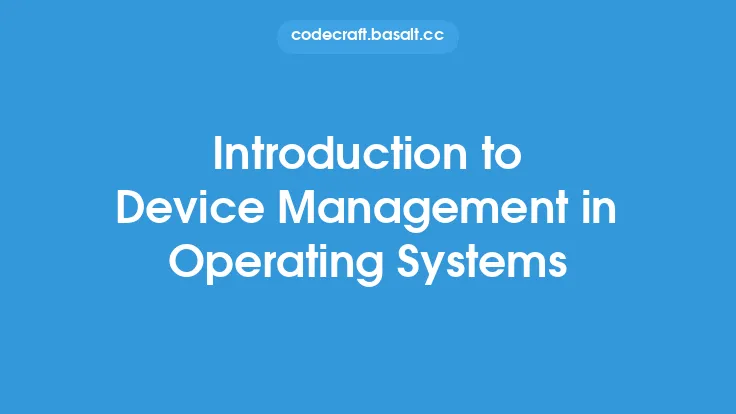Device drivers play a crucial role in the management of input/output (I/O) operations in operating systems. They act as a bridge between the operating system and the hardware devices, enabling the system to interact with the devices and perform various tasks. In this article, we will delve into the world of device drivers, exploring their role in I/O management, types, and functionality.
Introduction to Device Drivers
A device driver is a software component that allows the operating system to communicate with a hardware device. It is a program that translates operating system requests into a format that the device can understand, and vice versa. Device drivers are specific to each device and operating system, and they are usually provided by the device manufacturer or the operating system vendor. The primary function of a device driver is to manage the data transfer between the operating system and the device, ensuring that the data is transmitted correctly and efficiently.
Types of Device Drivers
There are several types of device drivers, each with its own specific function and characteristics. The most common types of device drivers are:
- Kernel-mode drivers: These drivers run in kernel mode, which means they have direct access to the hardware and can execute privileged instructions. Kernel-mode drivers are typically used for devices that require low-level access, such as disk drivers and network drivers.
- User-mode drivers: These drivers run in user mode, which means they do not have direct access to the hardware and must use system calls to interact with the device. User-mode drivers are typically used for devices that do not require low-level access, such as printer drivers and graphics drivers.
- Virtual device drivers: These drivers simulate the presence of a hardware device, allowing the operating system to interact with the device as if it were real. Virtual device drivers are typically used in virtualization environments, where multiple operating systems share the same hardware.
- Filter drivers: These drivers sit between the operating system and the device, filtering the data that is transmitted between them. Filter drivers are typically used to implement additional functionality, such as encryption or compression.
Device Driver Functionality
Device drivers perform several critical functions in I/O management, including:
- Device initialization: The device driver initializes the device, setting its configuration and parameters.
- Data transfer: The device driver manages the data transfer between the operating system and the device, ensuring that the data is transmitted correctly and efficiently.
- Interrupt handling: The device driver handles interrupts generated by the device, such as completion of a data transfer operation.
- Error handling: The device driver handles errors that occur during data transfer, such as data corruption or device failure.
- Device control: The device driver provides a interface for the operating system to control the device, such as setting its configuration or querying its status.
Device Driver Interface
The device driver interface is the set of functions and data structures that the operating system uses to interact with the device driver. The device driver interface typically includes:
- Device control functions: These functions allow the operating system to control the device, such as setting its configuration or querying its status.
- Data transfer functions: These functions allow the operating system to transfer data to and from the device.
- Interrupt handling functions: These functions allow the operating system to handle interrupts generated by the device.
- Error handling functions: These functions allow the operating system to handle errors that occur during data transfer.
Device Driver Development
Developing a device driver requires a deep understanding of the operating system, the device, and the device driver interface. The device driver development process typically involves:
- Device specification: The device manufacturer provides a specification for the device, including its configuration and parameters.
- Device driver design: The device driver developer designs the device driver, including its architecture and functionality.
- Device driver implementation: The device driver developer implements the device driver, using a programming language such as C or C++.
- Device driver testing: The device driver developer tests the device driver, ensuring that it functions correctly and efficiently.
Conclusion
In conclusion, device drivers play a critical role in I/O management, enabling the operating system to interact with hardware devices and perform various tasks. Understanding device drivers and their role in I/O management is essential for developing efficient and effective operating systems. By exploring the types, functionality, and interface of device drivers, we can gain a deeper appreciation for the complex interactions between the operating system, the device, and the device driver. As operating systems continue to evolve, the importance of device drivers will only continue to grow, making them a vital component of modern computing systems.





